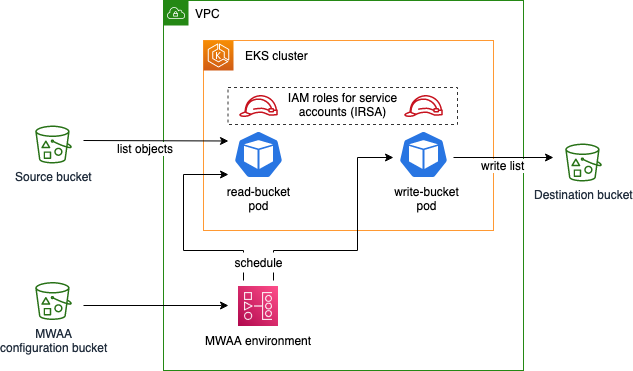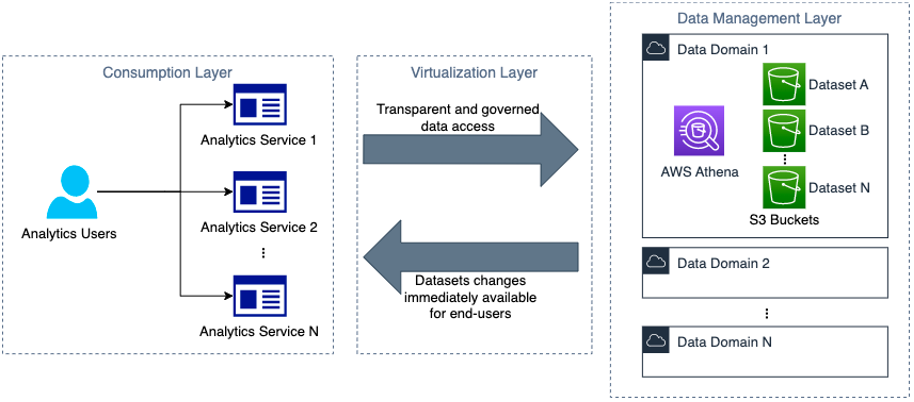AWS Big Data Blog
Category: Security, Identity, & Compliance
Set up fine-grained permissions for your data pipeline using MWAA and EKS
This blog post shows how to improve security in a data pipeline architecture based on Amazon Managed Workflows for Apache Airflow (Amazon MWAA) and Amazon Elastic Kubernetes Service (Amazon EKS) by setting up fine-grained permissions, using HashiCorp Terraform for infrastructure as code.
Build streaming data pipelines with Amazon MSK Serverless and IAM authentication
Amazon’s serverless Apache Kafka offering, Amazon Managed Streaming for Apache Kafka (Amazon MSK) Serverless, is attracting a lot of interest. It’s appreciated for its user-friendly approach, ability to scale automatically, and cost-saving benefits over other Kafka solutions. However, a hurdle encountered by many users is the requirement of MSK Serverless to use AWS Identity and Access Management (IAM) access control. At the time of writing, the Amazon MSK library for IAM is exclusive to Kafka libraries in Java, creating a challenge for users of other programming languages. In this post, we aim to address this issue and present how you can use Amazon API Gateway and AWS Lambda to navigate around this obstacle.
Generate security insights from Amazon Security Lake data using Amazon OpenSearch Ingestion
Amazon Security Lake centralizes access and management of your security data by aggregating security event logs from AWS environments, other cloud providers, on premise infrastructure, and other software as a service (SaaS) solutions. By converting logs and events using Open Cybersecurity Schema Framework, an open standard for storing security events in a common and shareable format, […]
Multi-tenancy Apache Kafka clusters in Amazon MSK with IAM access control and Kafka Quotas – Part 1
With Amazon Managed Streaming for Apache Kafka (Amazon MSK), you can build and run applications that use Apache Kafka to process streaming data. To process streaming data, organizations either use multiple Kafka clusters based on their application groupings, usage scenarios, compliance requirements, and other factors, or a dedicated Kafka cluster for the entire organization. It […]
Multi-tenancy Apache Kafka clusters in Amazon MSK with IAM access control and Kafka quotas – Part 2
Kafka quotas are integral to multi-tenant Kafka clusters. They prevent Kafka cluster performance from being negatively affected by poorly behaved applications overconsuming cluster resources. Furthermore, they enable the central streaming data platform to be operated as a multi-tenant platform and used by downstream and upstream applications across multiple business lines. Kafka supports two types of quotas: […]
Ingest, transform, and deliver events published by Amazon Security Lake to Amazon OpenSearch Service
With the recent introduction of Amazon Security Lake, it has never been simpler to access all your security-related data in one place. Whether it’s findings from AWS Security Hub, DNS query data from Amazon Route 53, network events such as VPC Flow Logs, or third-party integrations provided by partners such as Barracuda Email Protection, Cisco […]
Federate Amazon QuickSight access with open-source identity provider Keycloak
Amazon QuickSight is a scalable, serverless, embeddable, machine learning (ML) powered business intelligence (BI) service built for the cloud that supports identity federation in both Standard and Enterprise editions. Organizations are working toward centralizing their identity and access strategy across all their applications, including on-premises and third-party. Many organizations use Keycloak as their identity provider […]
How Novo Nordisk built distributed data governance and control at scale
This is a guest post co-written with Jonatan Selsing and Moses Arthur from Novo Nordisk. This is the second post of a three-part series detailing how Novo Nordisk, a large pharmaceutical enterprise, partnered with AWS Professional Services to build a scalable and secure data and analytics platform. The first post of this series describes the […]
Configure SAML federation for Amazon OpenSearch Serverless with AWS IAM Identity Center
Amazon OpenSearch Serverless is a serverless option of Amazon OpenSearch Service that makes it easy for you to run large-scale search and analytics workloads without having to configure, manage, or scale OpenSearch clusters. It automatically provisions and scales the underlying resources to deliver fast data ingestion and query responses for even the most demanding and […]
Role-based access control in Amazon OpenSearch Service via SAML integration with AWS IAM Identity Center
Amazon OpenSearch Service is a managed service that makes it simple to secure, deploy, and operate OpenSearch clusters at scale in the AWS Cloud. AWS IAM Identity Center (successor to AWS Single Sign-On) helps you securely create or connect your workforce identities and manage their access centrally across AWS accounts and applications. To build a […]









